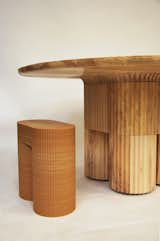
These 3D-Printed Wooden Tables and Chairs Aim to Disrupt the Cycle of Furniture Waste
Home furniture waste can appear like an insurmountable trouble Us citizens generate an approximated 12 million tons of it every year, with 80 percent heading to landfills and the greatest substance classification getting wooden. A the latest exhibition from sustainable household furniture style and design and manufacturing firm Design No., PROWL design and style studio, good artist Mike Han, and movement designer Natalie Liu put forth a shared objective to minimize the furnishings industry’s environmental footprint—and a strategy to reimagine the afterlife of wooden goods.
Entitled Endless Loop: From Waste to Wished, the collaboration, which debuted at the Solana Areas in Miami’s Wynwood district throughout this year’s Art Basel and Style and design Miami, showcased 1-of-a-variety PROWL stools and tables, standing sculptures and pendant lights by Product No., a towering monolith by Han, and an NFT collectible artwork by Liu, all designed completely from plant-based mostly, ethically sourced products these types of as FSC-licensed salvaged hardwoods. Astonishingly, every piece was 3D-printed too.
For the progressive manufacturing process, Design No. created its very own substantial-scale 3D printers that remodel salvaged wood squander into a paste-like material applied to fabricate just about every functional item. To make the paste-like substance, biodegradable polyesters or plant-primarily based resins are blended with fine wood dust, then compounded into small pellets and fed into the 3D printer. “When all those pellets are heated up and floor collectively within the 3D printer’s extruder, they kind into that ‘paste-like’ material that—once extruded under the correct conditions—cools, solidifies, and bonds with the prior printed layers into a sound, tough item,” states Model No. cofounder and main know-how officer Jeffrey McGrew, who made and created the company’s authentic industrial-scale 3D printers with mechanical style engineer Kevin Zumani.

Lauryn Menard and Baillie Mishler, founding designers of PROWL Studio, intended a salvaged hardwood table with a 3D-printed base and stools for the Infinite Loop collaboration.
Design No. personalized manufactured just about every perform for the collection making use of fallen ash wooden, sawdust, and upcycled plant waste sourced close to its micro-manufacturing unit by Bay Space wood supplier Arborica. (Ash trees are generally mulched or burnt when felled, so the items would normally go to squander.) “Ash was also decided on for its attractive overall look, energy, workability, commonality as a ‘salvaged’ tree, and the speed of its drying time,” says McGrew. What resulted was a collection of fashionable home furnishings and decor that is on par aesthetically with considerably of what you’d find at CB2 or Ikea, but was made to have a significantly fewer harmful effects on the setting.
Acquire the salvaged hardwood table with a 3D-printed foundation and stools developed by PROWL cofounders Lauryn Menard and Baillie Mishler, all with easy, rounded sorts. “At first look, the delicate styles of the desk and stools reference trunk-like pillars,” suggests Mishler. “But, the moment you’re up near and engaging with the pieces, you are going to see fluted facts impressed by the ropey bark identified on ash trees in their purely natural state that show off the nuanced and intricate abilities of the equipment employed to create the established.”

Great artist Mike Han labored with Model No.’s digital designers to produce the Countless Loop Monolith utilizing 3D printing tactics and salvaged ash wood.
Han’s contribution also features decorative grooves the staff digitally reduce the artist’s brushstrokes into the deal with of the ash monolith. On the reverse facet, the 3D printer included a convex mirror image of the brushstrokes working with sawdust recaptured for the duration of the milling and digital chopping actions. “My line get the job done is pushed and pulled as a result of a two-dimensional aircraft working with a subtractive and additive approach,” Han states, referencing the tactful use and redistribution of content the monolith exemplifies.
In contrast to traditional procedures of wood home furnishings manufacturing, Product No. says their 3D-printed home furniture emits 80 per cent significantly less greenhouse gasses. What’s more: The new wooden household furniture is biodegradable and can be composted or reused to 3D print foreseeable future solutions.
In addition to cutting down the furnishings industry’s carbon footprint and earning the most of quickly available supplies devoid of transporting them hundreds of miles, Product No. main government officer Philip Raub thinks 3D-printing techniques can also address the home furniture industry’s extensive wait periods: “On normal, our direct occasions are 50 percent of what we are viewing in the industry right now,” he states. “It is not a subject of whether it [3D printing] can be done, relatively when other folks are likely to commence transitioning to much better techniques.”
“It is much additional compostable than something in the field right now,” Menard adds. “If the industry bought driving this, we’d have a much much healthier globe in home furnishings.”
Top rated picture courtesy of Design No.
Connected Looking through:
A Trash Bag Couch, a Massive Bushy Chandelier, and Much more Tactile Treasures From Design Miami 2022
What It’s Definitely Like to Stay in a 3D-Printed Residence